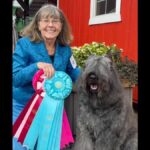Interview with Marybeth Acker, Breeder of MacIain Tibetan Spaniels
Where do I live? How many years in dogs? How many years as a breeder?
Marybeth Acker: I am a fourth-generation Conformation competitor and breeder, so I guess you can say that I was born into the sport. My family started in terriers (Scotties, Westies, and Airedales) and my parents had a MBIS Scottie, both here and in Europe, and bred Tibetan Terriers, producing top-winning dogs. I got my first Tibetan Spaniel in the late 1990s, desiring a dog that was lower maintenance and easier to travel with.
What is my kennel name? How many dogs do I currently keep?
Marybeth Acker: We have bred under the name MacIain for four generations. I am proud to say that we have had great success producing winning dogs in multiple breeds. While I co-own a number of dogs around the country, I currently have four dogs in my house.
Which have been my most influential sires and dams?
Marybeth Acker: MBISS CH Ambrier’s Nothing Gets Past Zeke, ROMX; GCHP MacIain’s North Side Irish – the top-winning Tibetan Spaniel of all time.
Can I talk a bit about my facilities? Where are my puppies whelped? How are they raised?
Marybeth Acker: I do not have a kennel facility that is separate from the house. My basement is outfitted with indoor runs, with easy access to the yard for dogs that I am raising or holding temporarily to show. Puppies are whelped in my bedroom at the foot of my bed. I use some of the Puppy Culture techniques, stimulating them and engaging with them daily. They stay upstairs until their eyes and ears are open, and moving them to better trafficked areas of the house. After weaning, they are moved downstairs where there is more activity. If I have dog shows on the calendar, they get to travel to shows and learn about being on the road and at shows.
What is my “process” for selecting show puppies? Performance puppies?
Marybeth Acker: Since the Breed Standard is the guideline for the structure of the dog, conformation and performance should ideally go together. The better the structure, the better it should perform. My priority is to determine which puppies should be kept for show or placed in show homes and which should be pets. I have a wonderful group of co-breeders and a few top professional handlers whom I will have evaluate my litters.
The evaluation process begins at birth, “when the puppies are still wet.” Bobby Clyde used to say, “You can see everything but teeth, tails, and testicles when they are born.” Once they are “dry,” I push off the temptation to evaluate puppies until they are eight weeks old, which is generally thought to be the moment that is the best predictor for the dog’s appearance as an adult.
Does my breed require any special preparation for competing in Conformance? In Performance Events?
Marybeth Acker: I think that preparation, whether for Performance or Conformation, begins from the ground up. The dog must be fed high-quality food in adequate amounts to assure correct growth, weight, and coat growth. I also use some coat growth supplements to maximize coat. While this is a small breed, they still require enough exercise to maintain their muscularity and substance. These dogs should not be feather-boned, frail, or soft.
A correctly conditioned Tibetan should be a durable, versatile dog. As with any coated breed, they require enough brushing to keep the dog free from mats and foreign substances that they can pick up outside. For a coated breed, the Tibetan’s coat maintenance is relatively easy; brushing, bathing, and removing the occasional mat. The Breed Standard states that these dogs are not to be trimmed, though there are some handlers who trim on their dogs.
In my opinion, is my breed in good condition overall? Any trends that warrant concern?
Marybeth Acker: Yes, I think the breed is in good condition, though I see too many dogs in the show ring that are too long or have weak rears. Within my circle of dog show friends who have a variety of breeds, there is a continuous discussion of whether breeders are breeding for wins or breeding to preserve and improve the breed. Breeding for success in the show ring is a tricky endeavor, where breeding for phenotype alone, without assessment of structure or genetics, makes our breed weaker in both areas. Acknowledging that the genome is fairly small, genetic testing is imperative and we must be able to have an open dialogue with other people in the breed. Kennel blindness only leads us to negative outcomes. I was in Orlando exhibiting two of my “specials” dogs but spent my time looking to see if there were dogs there that I would like to integrate into my breeding program, and I am excited that I found a few that I like that are nice outcrosses which will help to keep me from becoming bottle-necked in my own line.
Is my breed well suited to be a family dog? Who are the best candidates to own my breed?
Marybeth Acker: Tibbies really make wonderful pets, whether you live in an apartment or on a farm. They are versatile, easy to care for, durable, weather-resistant small dogs. They are smart, but they can be willful and more independent than many breeds; they are curious and like to think for themselves. Like any dog, they require training. I have trained dogs for Obedience and I have dogs competing in Agility and Fast CAT. Temperament within the breed varies as well. The breed is supposed to be aloof with strangers, and some of mine would prefer to only interact and snuggle periodically for short periods of time, while others didn’t read the Standard or they missed the word “aloof” and like being lapdogs. Either way, they do love their people.
What is the biggest misconception about my breed? What is my breed’s best-kept secret?
Marybeth Acker: The breed itself is a best-kept secret, but with that being said, I don’t want them to become super-popular because it lures the wrong type of people who just want to breed for money. Tibbies can be barky, but they are bright and can be taught to only bark at appropriate stimuli. Some people believe that coat care is hard or that they shed excessively. They are a low-shed breed that only sheds more during coat changes—and coat care is very easy.
As a Preservation Breeder, can I share my thoughts on the sport today? How’s the judging these days?
Marybeth Acker: What do I think about the number of shows? In my opinion, dog shows and the quality of exhibitors went downhill when the handlers tent went away and they moved from the tents to RVs and box trucks. Since handlers, breeders, and owner-handlers spent large amounts of time in close proximity to one another, there was more opportunity to connect with people and learn from the community around you. I learned “dogmanship” from the handlers who handled for my parents or who had their set-ups nearby. I was fortunate to learn from Bobby Clyde, Peter and Andrew Green, Joan Huber, Howard Huber, (no relation to Joan), and many others.
As for judging, I am just going to put this out there… we can all see that politics has usurped the judging of dogs. I like showing my own dogs, and I hate the fact that I feel like, sometimes, I need to put a handler on a dog that should win on its own. If you want to pick faces, maybe you shouldn’t judge dogs! The painstaking effort we put into breeding, raising, preparing, and showing dogs is truly taken for granted, and we are the only reason you have dogs to judge!
The number of shows today can be connected to my above statement about judging dogs. With the number of four- and five-day strings, a breeder or exhibitor who works for a living has a very hard time competing, especially if they are interested in competing for top Breed ranking. It only benefits those who have chosen to handle dogs professionally.
In my opinion, is social media good for sport? Is it harmful?
Marybeth Acker: It’s not going away. I worry that, too often, judges will pick dogs that they see being touted on social media or in magazines, while discounting dogs they are less familiar with.
What are the biggest challenges facing the dog show community as a whole today and how can these be addressed?
Marybeth Acker: I touched on this above; we need to be a community again. BRING BACK THE HANDLERS TENT. Yeah, I know, impossible, but if we could get more handlers inside at indoor shows… So “SNAP,” AKC doesn’t want OWNER HANDERS near the PROs. OH NO! The OH might learn something and be a better dog person. AKC needs to reevaluate the relationship between “PROs” and OH, especially PROs who are breeders too (most are).
What are some of the positive changes I’ve seen in the dog show community over the past decade?
Marybeth Acker: I think the addition of the Grand Champion titles is a great improvement. We are more likely to show our best dogs for longer periods of time, as there are still goals to be achieved.
If I could share one suggestion with judges of my breed, what would I like to say to them about my breed?
Marybeth Acker: Stop taking Tibetan Spaniel assignments when you don’t like or have not made the effort to understand the breed!
For a bit of fun, what’s the most amusing thing I’ve ever experienced with a Non-Sporting Dog?
Marybeth Acker: These little dogs are amusing almost all the time! “Bugsy,” whom I mentioned earlier, was left in the motorhome while we were showing other breeds. To our dismay, she was nowhere to be found. (Tibbies can escape through an open door, between your feet without you knowing.) So, we ran out to the showgrounds to hunt for her. We thought, since she loved showing, she might be trying to get in the ring or looking for Sharon in other set-ups. After a very frustrating few hours, we came back to the rig despondent that we had lost her. We pulled out a 24-pack of bottled water to water the dogs, and low and behold, there was Bugsy curled up on a towel behind the bottled water. She probably laughed at the stupid humans for making such a fuss.









